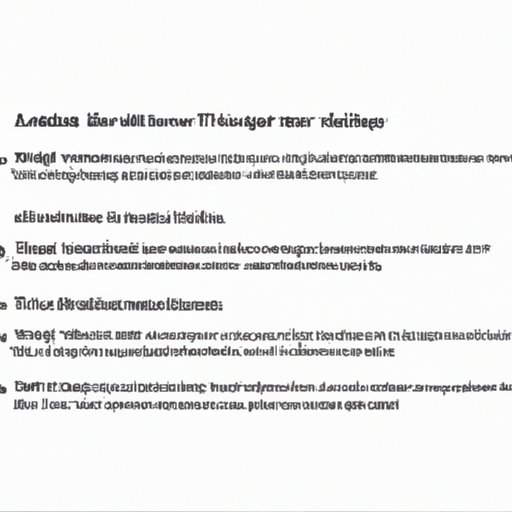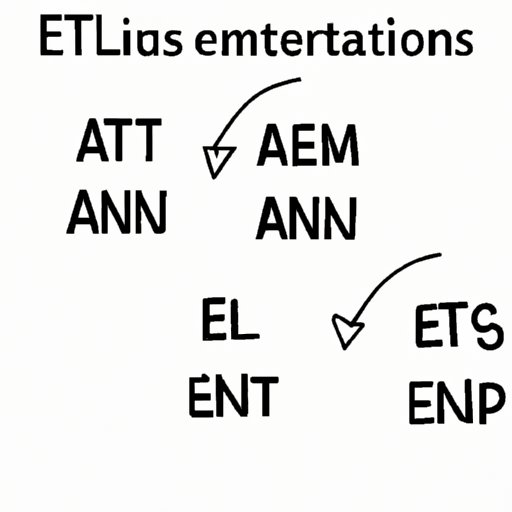
I. Introduction
If you are a student, researcher, or academic writer, you have probably come across the term “et al.” in your academic reading and writing. Et al. is an abbreviation of the Latin term “et alii” which means “and others”. The term is used to refer to additional authors not included in the citation or reference list. In academic writing, the use of “et al.” is critical for concise and effective communication of research ideas and concepts. This article will provide a comprehensive guide on how to use “et al.” in academic writing to improve the quality and clarity of your writing.
II. A Step-by-Step Guide on How to Use Et Al.
Et al. is commonly used in three situations in academic writing. These are in-text citations, reference lists, and footnotes. Here is a detailed explanation of how to use “et al.” in each of these situations.
In-Text Citations
In-text citations are used to acknowledge the contribution of other authors in your writing. When citing a work with more than three authors for the first time, all authors must be listed. For subsequent citations, only the first author’s name followed by et al. should be listed.
Example: (Smith, Jones & Petersen, 2012) -> (Smith et al., 2012)
Reference Lists
A reference list is a list of all the sources that have been cited in your writing. When citing a source with more than three authors in the reference list, only the first author’s name followed by “et al.” should be listed.
Example: Smith, J., Jones, K., Petersen, L., et al. (2012). The Impact of Climate Change on Biodiversity. Journal of Environmental Science, 5(1), 102-116.
Footnotes
Footnotes are used to add additional information to your writing without interrupting the flow of the main text. When citing a source with more than three authors in a footnote, only the first author’s name followed by “et al.” should be listed.
Example: Smith, Jones, Petersen, et al., The Impact of Climate Change on Biodiversity, Journal of Environmental Science 5, no.1 (2012): 102-116.
III. The History of the Use of Et Al. in Academic Writing
The use of “et al.” in academic writing can be traced back to the early 17th century when Latin was the language of scholarship and scientific communication. The abbreviation “et al.” comes from the Latin phrase “et alii” which means “and others”.
Over the years, the term has evolved to become a standard and widely accepted practice in scholarly writing to refer to additional authors. With the growth of collaborative research and increased complexity of scientific writing, the use of “et al.” has become an essential tool to present research findings in a clear and concise manner.

IV. Common Errors to Avoid When Using Et Al.
While the use of “et al.” is straightforward, there are common errors that writers make that can lead to confusion or misunderstanding. Here are some of the common errors to avoid:
Using “et al.” with one or two authors
“Et al.” should only be used when citing sources with more than three authors. When citing a source with one or two authors, always write their names in full.
Using “et al.” in the reference list for the first citation
For the first citation in the reference list, always list the names of all authors. Reserve the use of “et al.” for subsequent citations.
Incorrectly punctuating “et al.”
The correct abbreviation is “et al.” with a period after “al”. Avoid using “et. al” or “et al” without a period.
V. Different Citation Styles that Use Et Al.
There are different citation styles that use “et al.” to refer to additional authors. Here is an overview of how some of the most commonly used citation styles use “et al.”
APA Style
In APA style, “et al.” is used to refer to additional authors in in-text citations and reference lists. When citing a source with three to five authors in the first citation, all authors’ names should be listed. In subsequent citations, only the first author’s name followed by “et al.” should be listed.
Chicago Style
In Chicago style, “et al.” is used to refer to additional authors in in-text citations and footnotes. When citing a source with four or more authors, only the first author’s name followed by “et al.” should be listed.
MLA Style
In MLA style, “et al.” is used to refer to additional authors in in-text citations and works cited lists. When citing a source with four or more authors, only the first author’s name followed by “et al.” should be listed.
VI. The Meaning and Translation of Et Al.
Et al. is an abbreviation of the Latin term “et alii” which means “and others”. It is commonly used in academic writing to refer to additional authors beyond the first author listed. In other languages, the abbreviation may differ slightly, but the meaning remains the same.
For example, in French, “et al.” is translated as “et alii” or “et aliae” depending on whether the authors are male or female. In Spanish, “et al.” is translated as “y otros” which means “and others”.
VII. Tips on How to Use Et Al. Effectively
Using “et al.” effectively can enhance the clarity and conciseness of your academic writing. Here are some practical tips for using “et al.” in your writing:
Know when to use “et al.”
Remember only to use “et al.” when citing sources with more than three authors. If there are only one or two authors, write their names in full.
Be consistent with your usage.
When using “et al.”, be consistent with your usage throughout your writing. Ensure that you follow the guidelines of the citation style that you are using and apply them consistently throughout your writing.
Double-check your citations and reference lists.
When using “et al.”, ensure that you have cited your sources correctly and listed them appropriately in your reference list. Double-check your writing to ensure that there are no errors or omissions.
Do not overuse “et al.”
While the use of “et al.” is essential, overusing it can make your writing appear imprecise or unclear. Use “et al.” judiciously, only when necessary, and ensure that the rest of the citation or reference list is clear and complete.
VIII. The Impact of Et Al. on Scientific Research
The use of “et al.” in academic writing has a significant impact on the visibility and impact of scientific research. By referring to additional authors, “et al.” allows for concise and effective communication of research findings.
When academic publications have multiple authors, the use of “et al.” allows for a more inclusive approach, giving all the authors the same recognition and visibility. This can increase readership and citations, leading to more significant scientific impact.
Beyond its impact on individual publications, the use of “et al.” also allows for better discoverability of research as it can improve how search engines and databases index publications based on authorship.
IX. Conclusion
The use of “et al.” in academic writing is essential for concise and effective communication of research findings. Using “et al.” appropriately can enhance the quality and clarity of your academic writing. By following the step-by-step guide, avoiding common errors, and using the practical tips provided in this article, you can improve your academic writing and achieve greater visibility and impact for your research.




